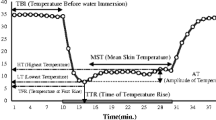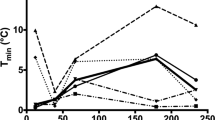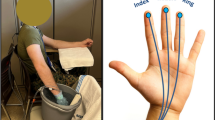Abstract
There are several types of cold adaptation based on the alteration of thermoregulatory response. It has been thought that the temperature of repeated cold exposures during the adaptation period is one of the factors affecting the type of cold adaptation developed. This study tested the hypothesis that repeated mild cold immersions would induce an insulative cold adaptation but would not alter the metabolic response. Seven healthy male participants were immersed to their xiphoid process level repeatedly in 26°C water for 60 min, 3 days every week, for 4 weeks. During the first and last exposure of this cold acclimation period, the participants underwent body immersion tests measuring their thermoregulatory responses to cold. Separately, they conducted finger immersion into 5°C water for 30 min to assess their cold-induced vasodilation (CIVD) response before and after cold acclimation. During the immersion to xiphoid process, participants showed significantly lower mean skin temperature and skin blood flow in the forearm post-acclimation, while no adaptation was observed in the metabolic response. Additionally, blunted CIVD responses were observed after cold acclimation. From these results, it was considered that the participants showed an insulative-type of cold acclimation after the repeated mild cold immersions. The major finding of this study was the acceptance of the hypothesis that repeated mild cold immersion was sufficient to induce insulative cold adaptation but did not alter the metabolic response. It is suggested that the adaptation in the thermoregulatory response is specific to the response which is repeatedly stimulated during the adaptation process.



Similar content being viewed by others
References
Alber-Wallerstrom B, Holmer I (1985) Efficiency of sweat evaporation in unacclimatized man working in a hot humid environment. Eur J Appl Physiol 54:480–487
Bittel JH (1987) Heat debt as an index for cold adaptation in men. J Appl Physiol 62:1627–1634
Budd GM, Brotherhood JR, Beasley FA, Hendrie AL, Jeffery SE, Lincoln GJ, Solaga AT (1993) Effects of acclimatization to cold baths on men’s response to whole-body cooling in air. Eur J Appl Physiol 67:438–449
Daanen HAM (2003) Finger cold-induced vasodilation: a review. Eur J Appl Physiol 89:411–426
Daanen HAM, Ducharme MB (1999) Finger cold-induced vasodilation during mild hypothermia, hyperthermia and at thermoneutrality. Aviat Space Environ Med 70:1206–1210
DuBois D, DuBois EF (1916) Clinical calorimetry. X. A formula to estimate the approximate surface area if height and weight be known. Arch Intern Med 17:863–871
Golden F, Tipton M (1988) Human adaptation to repeated cold immersions. J Physiol Lond 396:349–363
Hammel HT (1964) Terrestrial animals in cold: recent studies of primitive man. In: Dill DB, Adolph EF (eds) Hand book of physiology, Section 4 Adaptation to the environment. American Physiological Society, Washington DC, pp 413–434
Hardy JD, DuBois EF (1938) The technic of measuring radiation and convection. J Nutr 15:461–475
Hemingway A, Price WM, Stuart D (1964) The calorigenic action of catecholamines in warm acclimated and cold acclimated non-shivering cats. Int J Neuropharmacol 3:495–503
Hong SK (1973) Pattern of cold adaptation in women divers of Korea (ama). Fed Proc 32:1614–1622
Jansky L, Janakova H, Ulicny B, Sramek P, Hosek V, Heller J, Parizkova J (1996a) Changes in thermal homeostasis in humans due to repeated cold water immersions. Pflugers Arch Eur J Physiol 432:368–372
Jansky L, Sramek P, Savlikova J, Ulicny B, Janakova H, Horky K (1996b) Changes in sympathetic activity, cardiovascular functions and plasma hormone concentrations due to cold water immersion in man. Eur J Appl Physiol 74:148–152
Kang BS, Han DS, Paik KS, Park YS, Kim JK, Kim CS, Rennie DW, Hong SK (1970) Calorgigenic action of norepinephrine in the Korean women divers. J Appl Physiol 29:6–9
Krog J, Folkow B, Fox RH, Lange Andersen K (1960) Hand circulation in the cold of Lapps and North Norwegian fishermen. J Appl Physiol 15:654–658
LeBlanc J (1978) Adaptation of man to cold. In: Wang LCH, Hudson JW (eds) Strategies in cold. Academic, New York, pp 695–715
LeBlanc J (1988) Factors affecting cold acclimation and thermogenesis in man. Med Sci Sport Exerc 20:S193–S196
LeBlanc J, Hildes JA, Heroux O (1960) Tolerance of Gaspe fishermen to cold water. J Appl Physiol 15:1031–1034
LeBlanc J, Robinson D, Sharman DF, Tousignant P (1967) Catecholamines and short-term adaptation to cold in mice. Am J Physiol 213:1419–1422
Mekjavic IB, Eiken O (2006) Contribution of thermal and nonthermal factors to the regulation of body temperature in humans. J Appl Physiol 100:2065–2072
Mekjavic IB, Dobnikar U, Kounalakis SN, Musizza B, Cheung SS (2008) The trainability and contralateral response of cold-induced vasodilatation in the fingers following repeated cold exposure. Eur J Appl Physiol 104:193–199
O’Brien C, Young AJ, Lee DT, Shitzer A, Sawka MN, Pandolf KB (2000) Role of core temperature as a stimulus for cold acclimation during repeated immersion in 20°C water. J Appl Physiol 89:242–250
Pugh LG, Edholm OG (1955) The physiology of channel swimmers. Lancet 269:761–768
Purkayastha SS, Selvamurthy W, Ilavazhagan G (1992) Peripheral vascular response to local cold stress of tropical men during sojourn in the Arctic cold region. Jap J Physiol 42:877–889
Purkayastha SS, Ilavazhagan G, Ray US, Selvamurthy W (1993) Responses of Arctic and tropical men to a standard cold test and peripheral vascular responses to local cold stress in the Arctic. Aviat Space Environ Med 64:1113–1119
Radomski MW, Boutelier C (1982) Hormone response of normal and intermittent cold-preadapted humans to continuous cold. J Appl Physiol 53:610–616
Rees A, Eglin C, Taylor N, Hetherington M, Mekjavic IB, Tipton MJ (2002) The nature of human adaptation to cold. In: Proceedings of the 10th international conference on environmental ergonomics, Fukuoka, Japan, pp 143–146
Scholander PF, Hammel HT, Andersen KL, Loyning Y (1958a) Metabolic acclimation to cold in man. J Appl Physiol 12:1–8
Scholander PF, Hammel HT, Hart JS, Lemessurier DH, Steen J (1958b) Cold adaptation in Australian aborigines. J Appl Physiol 13:211–218
Takano N, Kotani M (1989) Influence of food intake on cold-induced vasodilatation of finger. Jap J Physiol 39:755–765
Tipton MJ, Pandolf KB, Sawka MN, Werner J, Taylor NA (2008) Physiological adaptation to hot and cold environments. In: Taylor NAS, Groeller H (eds) Physiological bases of human performance during work and exercise. Churchill, Livingstone, pp 379–400
Young AJ, Muza SR, Sawka MN, Gonzalez RR, Pandolf KB (1986) Human thermoregulatory responses to cold air are altered by repeated cold water immersion. J Appl Physiol 60:1542–1548
Acknowledgements
Authors wish to thank all participants in this study. We would also like to express our thanks to Mr M Fujiwara and Dr K Ishibashi for their technical advice and mechanical support. H. Wakabayashi and J.Y. Lee are the recipients of a research fellowship for young scientists from the Japan Society for the Promotion of Science. This study was supported by Grants-in-Aid for Scientific Research from Japan Society for the Promotion of Science (No. 21·3584). The authors declare that they have no conflict of interest.
Author information
Authors and Affiliations
Corresponding author
Rights and permissions
About this article
Cite this article
Wakabayashi, H., Wijayanto, T., Kuroki, H. et al. The effect of repeated mild cold water immersions on the adaptation of the vasomotor responses. Int J Biometeorol 56, 631–637 (2012). https://doi.org/10.1007/s00484-011-0462-1
Received:
Revised:
Accepted:
Published:
Issue Date:
DOI: https://doi.org/10.1007/s00484-011-0462-1




